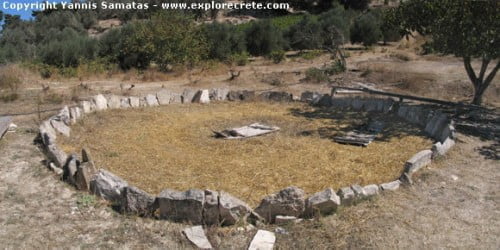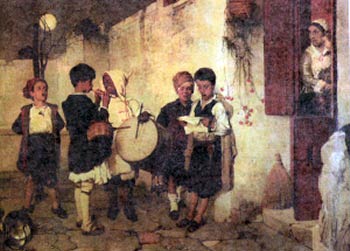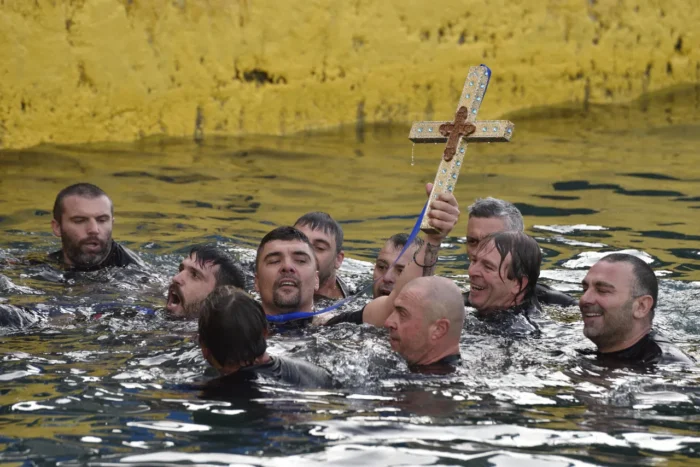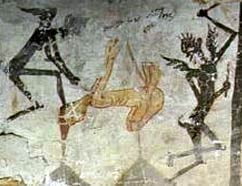Cretan Dagger, The Cretan knife
The Cretan Dagger by Nikos Vasilatos
This entire article regarding “The Cretan Dagger” was based on the wonderful book by Nikos Vasilatos of the same title. It is published by Classical Publishers, ISBN 960-220-470-2.
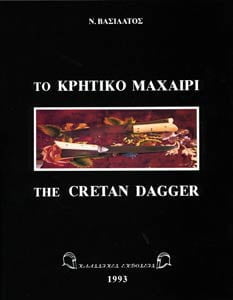
The first 52 pages of the book present a detailed history of the Cretan Dagger, and give valuable evidence about the history of the Cretan people and its fight for freedom and independence from its numerous conquerors.
Then the author moves on with a detailed description of the dagger itself: its characteristics, manner of manufacturing and detailed decorations. Also listed are mostly forgotten traditions and beliefs about The Cretan Dagger. The last chapter refers to the folk songs and poetry surrounding the dagger.
Those pages have been published separately in the English language and may be requested from the author.
The book also contains 65 full-page photos and lithographs starting from the end of the 19 th century. For each photograph there is important analytical comments in Greek and English, offering additional historic, artistic and folklore data – proving this book to be an invaluable document for this particular fold in the history of the Cretan people.
We warmly thank Mr. Vasilatos for sending us a copy of his book, which inspired the creation of this dedication.
Yannis Samatas
www.explorecrete.com
The Cretan Dagger, the knife of Crete
This work was realized in an effort to honour and preserve in the memory of modern generations an art that flourished in the island of Crete throughout the 19th and in the early 20th century and which is slowly and imperceptibly disappearing today, undermined by the pressure of modern technology and the shrinkage of the demand in handy products used by people in their everyday lives in earlier times.
It is the art of manufacturing the hand – made Cretan dagger, which has been so much loved by the Cretans, but in a few years will cease to be manufactured in the traditional manner, since faceless technology is gradually replacing the art, skill, mastery and creative enthusiasm of the last Cretan dagger – manufacturers.
The Cretan dagger, inseparable companion of every Cretan in the old times, accompanied the Cretans wherever they went, either as travelers or as immigrants, when in hard times some of them where forced to abandon their beautiful island. Thus, the Cretan dagger can be found not only in Crete and in the other regions of Greece, but also at the ends of the earth ; from Egypt to Russia and from the U.S.A. and Canada to Australia, either in the houses of Cretans as a valuable heirloom, or in second – hand and antique shops, dusted and without identity, among a heap of disparate objects, waiting for the person that will recognize and obtain it, paying a certain amount in consideration. Each of them hides its own story, humble or glorious, connected with the island of Crete and Cretan gallantry.
Since, then, tradition and historical documents are of cultural value and credibility, the hand – made Cretan dagger deserves to be studied and honoured, before its traditional manufacturing technique perishes in the boundless course of time. For, above all, whenever a traditional art perishes, human culture is impoverished.
History of the Cretan Dagger
One of the first tools manufactured by man, which helped him survive in the long and difficult era of the dawn of civilization, is the dagger, the first edged weapon. In manufacturing it, man imitated the shape of the nails of wild animals, with which they catch and kill their prey.
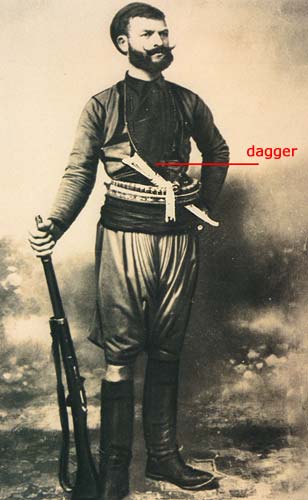
One of the most ancient specimens of daggers in the form we know them today was found in Gebel El Arak , Egypt. It is made of processed obsidian stone and it has an ivory hilt, decorated with embossed portrayals of scenes inspired by war. This dagger was manufactured circa 3.400 BC and is kept today in the Louvre Museum . However, daggers approaching the age of 5.000 years have also been found in China , Mesopotamia and Iran ‘s Luristan.
Exquisite double – edged bronze and copper daggers were manufactured in Mycenaean Greece from 1.500 BC onwards, which were brought by merchants motivated by profit to many other distant regions in Europe , since the export trade of weapons thrived during the Mycenaean age.
However, in classical Greece too, there was a flourish in the fabrication of numerous edged weapons, mainly daggers, which were used in the innumerable wars that ravaged Greece during the classical age.
At the heyday of Mycenaean civilization, daggers of notable quality were manufactured in Minoan Crete, which bequeathed to us many brilliant works of an advanced and, at the same time, singular civilization. However, few specimens have survived to our days. Among the exhibits of the Heraklion Museum there is a Minoan age statuette of a warrior from Sitia, armed with a dagger presenting certain similarities to modern Cretan daggers. It should be mentioned that, according to ancient Greek mythology, edged weapons and war helmets were first fabricated in Crete , since it was the Couretes, Zeus’s retinue, who were considered to be their inventors.
The defence needs of the biggest Greek island resulted in the development of metallurgy and, by extension, the manufacturing of weapons in Crete during the classical age, when the island’s archers enjoyed high renown throughout Greece and Asia Minor for their skill in using their weapons. During the Roman era, the Romans had a bitter experience of the Cretan’s battle skills and the accuracy of their archers during their efforts to occupy the island.
In the Middle Ages, and specifically in the 9th century, Crete was occupied by the Saracenes, who came from Spain . Using the island as base of their operations, they plagued the entire eastern Mediterranean with their raids. The Saracenes of Crete manufactured various types of weapons on the island and used them to arm their ships and crews during their naval raids.
After the victorious campaign of Nicephorus Phocas and the vanquishment of the Saracenes of Crete, the island was restored to Byzantine rule, under which it remained until the early 13th century, when it was vested in the Venetians as their valuable booty from the share – out of the Byzantine Empire ‘s lands, after the latter had been dismantled by the Crusaders of the Fourth Crusade.
The Venetians kept Crete under their domination for more than 450 years. This was made possible by the excellent organization of their administrative machine and by the defense system they had deployed on the island, whereby, in addition to the powerful regular military forces, defense was reinforced by a local militia of Cretan archers, renowned throughout the East, and by the forces of the Greek and Italian landowners of the island. The latter forces were certainly armed with weapons manufactured on the island by Cretan craftsmen.
Written sources referring to the revolution of the Psaromilingos, which was a noble Cretan family, against the Venetians in the mid- 14th century testify to the use of daggers for military purposes in the Middle Ages. During that revolution, the Cretan rebels were armed with arches, spears, bludgeons, large knives and axes’.
According to the oral tradition, during the Venetian occupation there were dagger manufacturing workshops in Heraklion of Crete, established at exactly the same site as they are today.
After the conquest of the island by the Turks, the island’s metallurgists continued to fabricate exquisite metallurgical products, including daggers, which acquired special value during the 19th century repeated revolutions of the Cretans, who thirsted for freedom.
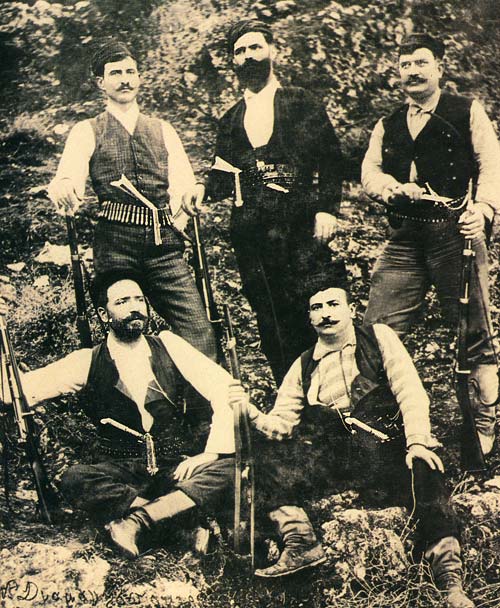
The sentimental and, at the same time, practical value of the Cretan dagger in battle did not perish in our century, since the Cretan dagger was the necessary complement of every gallant Cretan youth’s armament in the struggle over Macedonia, the Balkan Wars, the Asia Minor Campaign and even during the Second World War, when the weapons of Cretan partisans included the traditional Cretan dagger, symbol of Cretan gallantry and the spirit of Crete’s resistance against any conqueror.
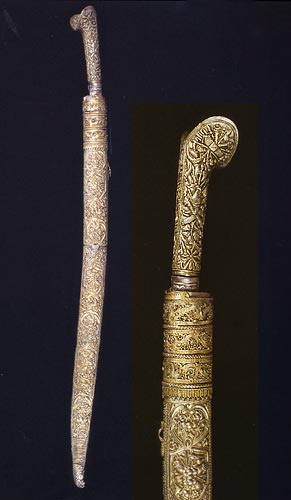
The yataghan of Daskaloyannis, the leader of the Cretan revolt against the Turks in 1770
- The Cretan Dagger, Part 1: the knife of Crete
- The Cretan Dagger, Part 2: Description & manufacturing of the Cretan Dagger
- The Cretan Dagger, Part 3: The Cretan Dagger in manners, habits, popular beliefs and magical ceremonies
“The Cretan Dagger “
Nikos Vasilatos
Classic Editions
ISBN 960-220-470-2
tel. +30-210 3639418
email: N. Vasilatos
© explorecrete.com All Rights Reserved. Reproduction or copying without permission is prohibited.

